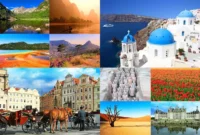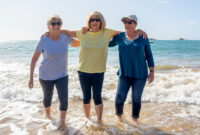Seniors traveling alone: The image conjures up visions of independence, adventure, and the fulfilling pursuit of personal exploration. Yet, the reality often involves careful planning, proactive safety measures, and a mindful approach to health and well-being. This guide delves into the practicalities and emotional aspects of solo senior travel, providing a roadmap for a safe, enriching, and memorable experience.
From meticulous itinerary creation and budget management to navigating accessible travel options and addressing potential health concerns, we’ll cover the essential steps to ensure a successful journey. We’ll also explore the unique social and emotional dimensions of solo travel for seniors, offering insights into fostering connections and maintaining well-being while embracing the freedom of independent exploration.
Planning and Logistics of Solo Senior Travel
Embarking on a solo trip as a senior citizen can be a rewarding experience, offering independence and the freedom to explore at your own pace. Careful planning, however, is crucial to ensure a safe and enjoyable journey. This section will guide you through the essential steps involved in organizing your solo adventure.
Budgeting for Solo Senior Travel
Creating a realistic budget is paramount. Consider all aspects of your trip, from flights and accommodation to daily expenses like meals and activities. Start by determining your overall budget, then allocate funds to each category. Utilize online budgeting tools or spreadsheets to track expenses and ensure you stay within your financial limits. Remember to factor in unexpected costs, such as medical emergencies or flight delays, by setting aside a contingency fund. For example, a two-week trip to Europe might require a budget of $3,000 – $5,000 depending on your travel style and chosen destinations. Consider using travel reward points or senior discounts where applicable to reduce costs.
Itinerary Creation for Solo Senior Travelers
Develop a flexible itinerary that balances structured activities with ample free time. Research potential destinations and attractions that align with your interests and physical capabilities. Prioritize activities that are manageable and avoid over-scheduling your days. Include buffer time for unexpected delays or changes in plans. For instance, a seven-day itinerary might include three days of planned sightseeing, two days of relaxation, and two days for spontaneous exploration. Consider the pace you are comfortable with and don’t try to cram too much into a single day.
Booking Accommodations for Solo Senior Travel
Choose accommodations that cater to the needs of senior travelers. Look for hotels or guesthouses with accessible features, such as elevators and ramps. Consider proximity to transportation and medical facilities. Read reviews carefully to assess the cleanliness, safety, and overall suitability of the accommodation. Booking in advance is advisable, especially during peak seasons, to secure your preferred choice and potentially obtain better rates. Websites specializing in senior travel often offer packages that include accommodation and other services.
Transportation Options for Solo Senior Travelers
Several modes of transportation are suitable for senior solo travelers, each with its own advantages and disadvantages.
| Mode of Transportation | Advantages | Disadvantages |
|---|---|---|
| Air Travel | Fast, convenient for long distances | Can be stressful, potential for delays, physical exertion involved |
| Train Travel | Relaxing, scenic views, often more comfortable than buses | Can be slower than air travel, may not reach all destinations |
| Bus Travel | Affordable, accessible to many destinations | Can be less comfortable, longer journey times |
| Rental Car | Flexibility and independence | Requires a valid driver’s license, can be stressful in unfamiliar areas |
Consider your personal preferences, physical capabilities, and the distances involved when choosing your transportation method.
Obtaining Necessary Travel Documents for Solo Senior Travelers
Ensure your passport is valid for at least six months beyond your intended travel dates. Check visa requirements for your destination well in advance, as processing times can vary. Obtain any necessary travel insurance that covers medical emergencies and trip cancellations. Make copies of all important documents, including your passport, visa, and insurance policy, and store them separately from the originals. It’s also wise to inform your bank and mobile phone provider of your travel plans to avoid any issues with access to funds or communication. A detailed medical summary including any allergies or pre-existing conditions is also recommended to carry.
Sample 7-Day Solo Trip Itinerary: A Relaxing Escape to Tuscany, Italy
This itinerary focuses on a slower pace suitable for senior travelers, emphasizing relaxation and cultural immersion. Costs are estimates and can vary depending on the season and your choices.
- Day 1: Arrival in Florence & Hotel Check-in (Estimated cost: $150 – accommodation, $50 – dinner)
- Day 2: Florence – Uffizi Gallery & Ponte Vecchio (Estimated cost: $50 – gallery entry, $40 – lunch, $30 – dinner)
- Day 3: Florence – Duomo & Accademia Gallery (Estimated cost: $40 – gallery entry, $40 – lunch, $30 – dinner)
- Day 4: Day Trip to Siena & San Gimignano (Estimated cost: $100 – guided tour, $50 – lunch)
- Day 5: Cooking Class & Tuscan Wine Tasting (Estimated cost: $150 – cooking class & wine tasting)
- Day 6: Relaxation & Exploration of Florentine Markets (Estimated cost: $50 – lunch, $30 – dinner)
- Day 7: Departure from Florence (Estimated cost: $50 – airport transfer)
Note: This is a sample itinerary. Adjust the activities and pace to suit your preferences and physical capabilities. Always factor in travel time between locations.
Last Word
Embarking on a solo adventure as a senior is a testament to a spirit of independence and a thirst for new experiences. By carefully considering the safety, logistical, health, and emotional aspects outlined in this guide, seniors can confidently plan and enjoy enriching journeys. Remember, thorough preparation and a proactive approach are key to maximizing the rewards and minimizing the risks of solo travel, allowing for a truly unforgettable and fulfilling experience.




